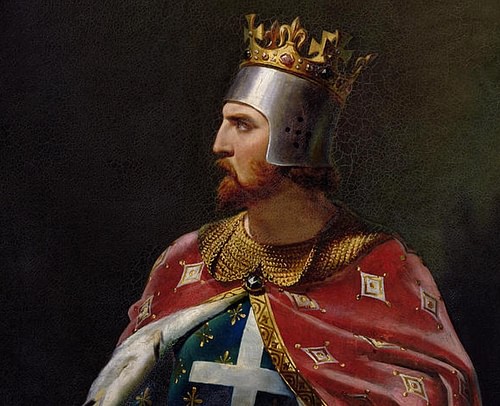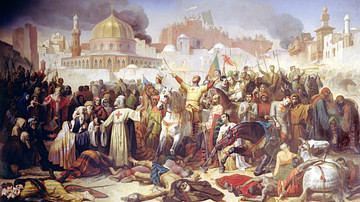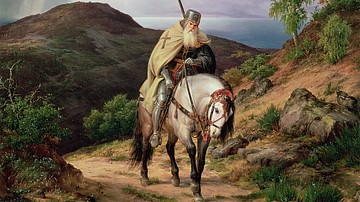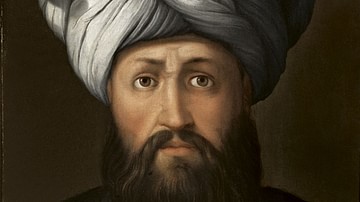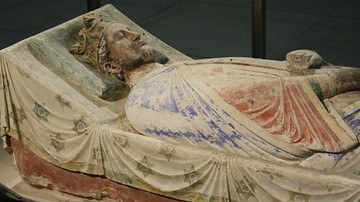
The Third Crusade (1189-1192 CE) was launched to retake Jerusalem after its fall to the Muslim leader Saladin in 1187 CE. The Crusade was led by three European monarchs, hence its other name of 'the Kings' Crusade'. The three leaders were: Frederick I Barbarossa, King of Germany and Holy Roman Emperor (r. 1152-1190 CE), Philip II of France (r. 1180-1223 CE) and Richard I 'the Lionhearted' of England (r. 1189-1199 CE). Despite this pedigree, the campaign was a failure, the Holy City never even being attacked. Along the way, there were some victories, notably the capture of Acre and the battle of Arsuf. Fizzling out with a whimper, the Crusade collapsed because, by the time they arrived at their objective, the western leaders found themselves without sufficient men or resources to resist the still intact armies of Saladin. Although a compromise was negotiated with access for pilgrims to Jerusalem permitted and a Christian foothold maintained in the Middle East, another attempt to take the Holy City would shortly be made the original objective of the Fourth Crusade of 1202-1204 CE.
The Fall of Jerusalem
The Second Crusade (1147-1149 CE) had effectively ended with the complete failure to take Damascus in Syria in 1148 CE. The various Muslim states in the Middle East then realised that the once-feared western knights could be defeated and the precarious existence of the Crusader-held territories, the Latin East, was starkly highlighted. All that was needed now was a unification of Muslim forces and this was provided by one of the greatest of all medieval rulers, Saladin, the Sultan of Egypt and Syria (r. 1174-1193 CE).
Saladin, the founder of the Ayyubid dynasty in Egypt, took control of Damascus in 1174 CE and Aleppo in 1183 CE. Saladin then shocked the world by defeating the army of the Kingdom of Jerusalem and its Latin allies at the Battle of Hattin in 1187 CE. Thus, Saladin was able to take control of such cities as Acre, Tiberias, Caesarea, Nazareth, Jaffa and even, the holiest of holies itself, Jerusalem. Remarkably lenient with his Christian captives compared to the butchery of the First Crusade (1095-1102 CE), after the recapture of Jerusalem almost a century earlier, Saladin accepted ransoms from those Latin Christians who could afford to buy their freedom and enslaved the rest. Eastern Christians were permitted to remain in Jerusalem as a protected minority group. The Latin East had all but collapsed, only Tyre remained in Christian hands, under the command of Conrad of Montferrat, but it would prove a useful foothold for the coming fightback.
Pope Gregory VIII only reigned for a few months in 1187 CE but, in October of that year, he made a lasting impact on history by calling for yet another crusade to win back Jerusalem and such lost holy relics as the True Cross. Nothing less than a repeat of the remarkable feat of the First Crusade would do. No fewer than three monarchs took up the Pope's challenge: the Holy Roman Emperor, Frederick I Barbarossa, king of Germany, Philip II of France and Richard I of England. With these being the three most powerful men in western Europe, the campaign promised much.
Death of Frederick I Barbarossa
Frederick I Barbarossa was the first king to mobilise, and he travelled with his army by land through Thrace in the spring of 1190 CE. The Byzantine Emperor Isaac II Angelos (r. 1185-1195 CE) was understandably wary of this western army passing through his territory while, from the other side, the westerners were deeply suspicious of Isaac's new alliance with Saladin, a feeling based on some reality as Isaac did try to impede the Crusaders' progress towards the Middle East. When Frederick occupied Adrianople in Thrace, the Byzantines became more helpful to their fellow Christians but the Emperor was no doubt relieved once the Germans had passed on into Anatolia.
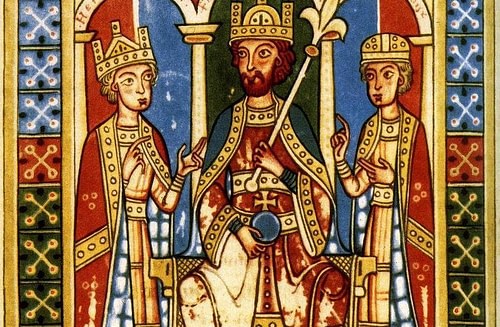
Then disaster struck on 10 June 1190. The Holy Roman Emperor drowned in an accident, falling from his horse into (or suffering a heart attack while swimming in) the River Saleph in southern Cilicia still on his way to the Holy Land. Frederick's death, and then a calamitous outbreak of dysentery, resulted in most of his army being eliminated or deciding to trudge back home in grief. The Crusade would have to rely on the English and French armies, temporary allies who were not very fond of each other at the best of times. Although a few German troops made it to Acre in the Middle East, the loss of Frederick's authority and experience would prove to be significant for the Crusade as a whole.
Richard I Takes Sicily & Cyprus
Meanwhile, Richard I took the sea route to the Middle East. The experienced campaigner, as meticulous as ever, had swung his entire kingdom's resources towards the campaign, amassing a fleet of 100 ships and 60,000 horses. On his way, Richard captured Messina on Sicily in 1190 CE, and when the king's army grouped for the first time on the island in April 1191 CE, there were 17,000 soldiers ready for action. The English king knew full well that the make-or-break factor for any campaign was logistics and he set about ensuring he had a good line of supply by next capturing Cyprus. Officially still Byzantine, the island now had a rebel leader, Isaac Komnenos, who had proclaimed himself its independent ruler. Richard proved unstoppable and, with the rather tame excuse that the locals had not treated some shipwrecked Crusaders very kindly, Cyprus was taken in May 1191 CE. The island's inhabitants were forced to pay a 50% tax on all possessions to further boost the Crusader king's campaign coffers. The Crusaders would govern the island, subsequently used as a supply base for armies on their way to the Middle East, until the Venetians took over in 1571 CE.
Meanwhile in France, Philip II had amassed his army of 650 knights, 1,300 squires, and an even larger number of infantry. This army also sailed to the Levant, this time thanks to Genoese ships who would take it to Acre. The Third Crusade was certainly developing into a truly pan-European military escapade.
The Siege of Acre
The first major battle of the campaign was at Acre, on the coast of the Kingdom of Jerusalem. Actually, the city had already been under siege for some time by an army led by the French nobleman Guy of Lusignan, king of what remained of the Kingdom of Jerusalem (r. 1186-1192 CE). However, Guy was struggling as he now faced an army sent by Saladin to relieve the city. Fortunately for the Latin ruler, several Crusader armies shortly arrived in support: the remains of Frederick's army, a German contingent led by Duke Leopold of Austria which had travelled by sea, a French force led by Henry of Champagne, and the armies of Richard I and Philip II. By early June 1191 CE, all the Crusaders were in place and ready to take the city.
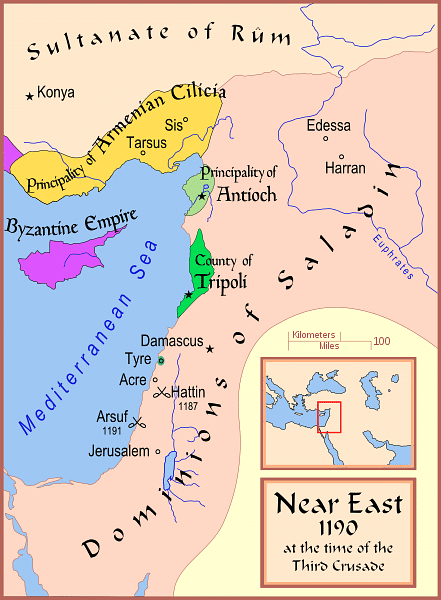
A heavy and sustained bombardment using catapults was launched but the protracted siege was only finally successful when sappers, offered cash incentives by Richard, undermined the fortification walls of the city on the land side. The English king's siege engines and reputation, and divisions in Saladin's own army were additional factors in the victory. The 'Lionhearted', as Richard was now known thanks to his courage and audacity in warfare, had achieved in five weeks what Guy had failed to do in 20. The city was finally captured on 12 July 1191 CE, and with it, significantly, 70 ships, the bulk of Saladin's navy. According to legend, Richard had been ill at the time, perhaps struck down by scurvy, although he had retainers carry him on a stretcher so that he could fire at the enemy battlements with his crossbow. Richard then rather blemished his 'good king' reputation when he ordered 2,500 prisoners to be executed. The English king felt the delay in paying the agreed ransom for them needed a firm riposte, and to release them would only have meant they sooner or later rejoined the enemy army.
Guy of Lusignan, meanwhile, was made the new king of Cyprus which had been sold by Richard to the Knights Templar (more cash for the cause). Back in the Levant, unfortunately, Philip was obliged to return home in August 1191 CE due to political problems in Flanders which threatened his throne. Thus, from the original three kings, the Crusader army now had only one. Still, Richard was probably the greatest general of his generation, and the campaign, despite its setbacks, was off to a fine start.
The Battle of Arsuf
The Crusader army next set its sights on Jaffa, the vital port which supplied Jerusalem, but on their way there Saladin, after a few days of ineffective harassing tactics on the marching army, decided that the best way to deal with the invaders was a full-on field engagement. On 7 September 1191 CE, on the plain of Arsuf, the two armies clashed in a running battle, the Crusaders being careful to follow the coast and so leave only one flank of their column exposed. The Muslim mounted and infantry archers, as well as infantry lance-bearers, attacked the marching Crusader infantry who, as usual, formed a protective block around the heavy cavalry units. After skirmishes for most of the day, the westerner's heavy cavalry was unleashed to devastating effect, although the initial charge was perhaps an unauthorised one by the Knights Hospitaller. The Crusaders won the battle but the Muslim losses were not substantial - Saladin having had no choice but to withdraw to the relative safety of the forest which bordered the plain.
The Crusaders then marched on to Jaffa to rest and regroup. Although Richard preferred to first secure Egypt and so isolate the enemy's logistical base, most of the Crusaders were intent on striking straight for Jerusalem, which was, after all, the original goal of the Crusade. The English king bowed to popular demand and moved for the Holy City but only after a cautious advance where strategically important castles protecting the army's supply lines were captured and fortified. Consequently, the Crusader army had still not reached its goal by January 1192 CE. The wet weather was not speeding up the advance either, and still 19 kilometres from their ultimate goal and with their supply lines precarious, a fateful decision was made.
Jerusalem & A Negotiated Peace
Richard had marched to within sight of Jerusalem, but he knew that even if he could storm the city's formidable fortifications, his army had been so reduced by the various battles over the past two years that he would most likely not be able to hold it against an inevitable counterattack. It was a decision supported by the commanders of both of the army's two most experienced fighting units: the Knights Templar and Knights Hospitaller. Now more than ever the loss of Frederick's army was most keenly felt. Another march was made on Jerusalem the following year, but, as before, it stopped short and the leaders once again decided they might, as at Acre, take the city after a long siege but they would almost certainly be unable to stave off a counterattack from Saladin.
Meanwhile, the Muslim leader decided to attack Jaffa, which was taken in July 1192 CE. Richard, by then at Acre, sailed and arrived at Jaffa on 1 August, determined to get the city back again. Leading from the front, the “Lionhearted” achieved his goal against improbable odds, but in terms of the bigger picture not much had changed. The Muslims still controlled Jerusalem and Saladin still had his army intact. It was something of a stalemate and, in any case, as with Philip, domestic affairs in England necessitated Richard's prompt return home to safeguard his throne in October 1192 CE. The whole Crusade project was effectively abandoned. No Crusader army would ever get as close to Jerusalem again.
Richard salvaged something for all the effort and negotiated a peace deal with Saladin at Jaffa. The Crusader-held fortress of Ascalon had to be given up and dismantled while a small strip of land around Acre was to be kept by the Crusaders, and the future safe treatment of Christian pilgrims to the Holy Land was also bargained for. It was not quite what was hoped for at the outset, but there could always be a Fourth Crusade at some time in the future. Indeed, Richard noted that in any future campaign against the Arabs it would be advantageous to attack from Egypt, the weak underbelly of their empire. It was precisely this plan which the Fourth Crusaders (1202-1204 CE) adopted, even if they again were distracted from their original objective, this time by the jewel of Byzantium: Constantinople.
